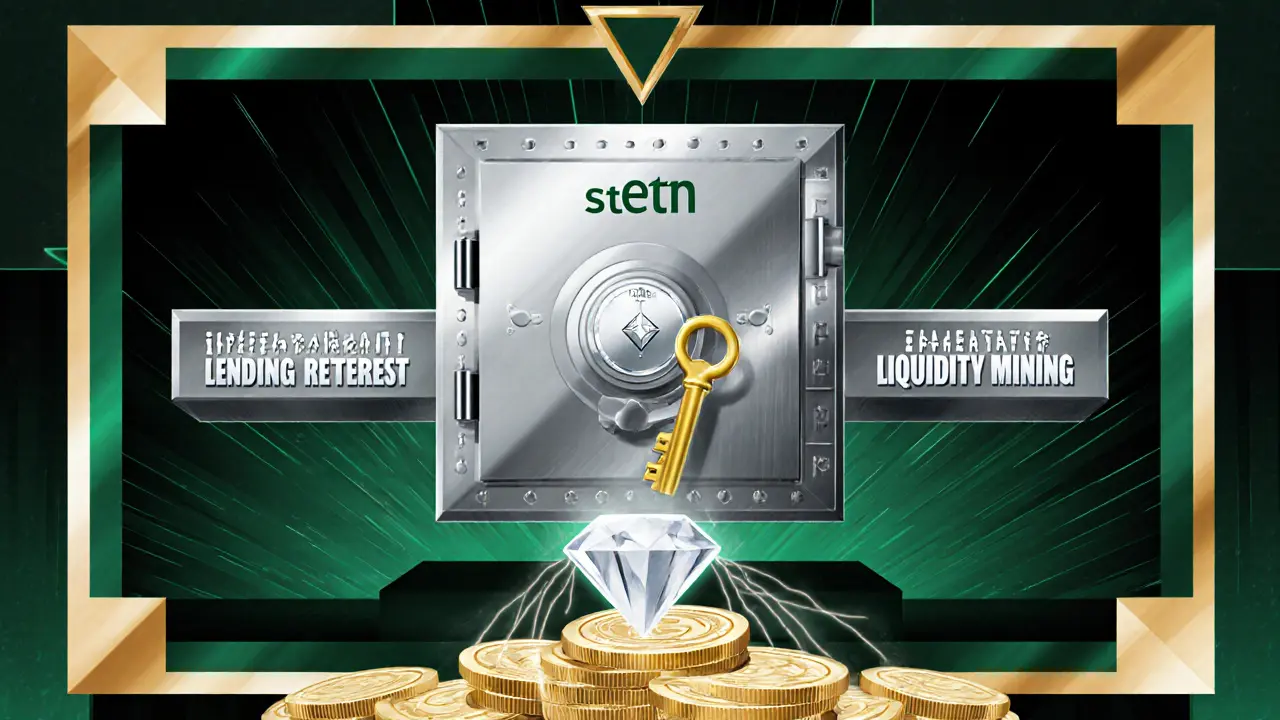Liquid Staking Yield Calculator
Compare your potential returns using traditional staking versus liquid staking with DeFi strategies.
Your Investment
How It Works
With liquid staking, you stake your ETH to receive LST (like stETH), then use it as collateral in DeFi to earn additional yield. The example in the article shows how this creates compound returns.
Example: 10 ETH staked → 10 stETH → $7 ETH borrowed → 8% yield on liquidity → Total 12-18% APY
Your Potential Returns
Traditional Staking
Annual Reward: $0.00
Total Value: $0.00
Liquid Staking + DeFi
Annual Reward: $0.00
Total Value: $0.00
Important: These are theoretical projections based on the article's examples. Actual returns may vary due to market conditions, protocol risks, and tax implications. Liquid staking carries risks including depegging and smart contract vulnerabilities.
Imagine locking up your ETH to earn staking rewards-only to find you can’t use it anywhere else. No trading. No lending. No earning extra yield. That’s traditional staking. It’s secure, sure, but it’s also a capital trap. You’re stuck. Your money sits idle while the rest of DeFi moves fast. Liquid staking changes all that. It doesn’t just let you stake your crypto-it lets you use it while you stake it.
What Liquid Staking Actually Does
Liquid staking solves a simple but huge problem: illiquidity. When you stake ETH directly on Ethereum, your tokens are locked for weeks-even after you request to withdraw. You earn 3-5% APY, but you can’t touch your funds. Liquid staking flips this. You deposit ETH into a protocol like Lido or Rocket Pool. In return, you get a token-stETH or rETH-that represents your staked ETH plus future rewards. This token is fully liquid. You can trade it, send it, or use it as collateral in DeFi apps like Aave or Uniswap.It’s not magic. It’s smart contracts and validator networks working together. The protocol stakes your ETH on the Ethereum network. It then mints an equal amount of LST (Liquid Staking Token) and sends it to you. Every time your ETH earns rewards, your LST balance grows automatically. No manual claiming. No waiting. And because LSTs are ERC-20 tokens, they work everywhere Ethereum does.
Why Capital Efficiency Matters
Capital efficiency means using your money more than once at the same time. In traditional finance, you can’t lend your house and rent it out simultaneously. In crypto, liquid staking lets you do exactly that with ETH.Here’s how it works in practice:
- You stake 10 ETH through Lido and get 10 stETH.
- You earn 4% staking rewards annually-about 0.4 ETH per year.
- You deposit your 10 stETH into Aave as collateral and borrow 7 ETH.
- You use that 7 ETH to provide liquidity on Uniswap, earning 8% APY.
- You’re now earning staking rewards + lending interest + liquidity mining-potentially 12-18% total APY.
That’s not theoretical. Reddit users in March 2024 documented real cases where $10,000 in stETH generated $2,300 in extra yield over six months using this exact strategy. That’s 23% annualized return on the same capital-something impossible with locked staking.
Liquid Staking vs. Traditional Staking
| Feature | Liquid Staking | Traditional Staking |
|---|---|---|
| Liquidity | Full liquidity with LSTs (tradeable, usable in DeFi) | Locked for 7-21 days after withdrawal request |
| Minimum Stake | As low as 0.01 ETH | 32 ETH required |
| Yield Sources | Staking rewards + DeFi yields (lending, liquidity mining) | Staking rewards only (3-5% APY) |
| DeFi Compatibility | High-works with Aave, Curve, Uniswap, etc. | None-tokens are locked and non-transferable |
| Operational Complexity | Low-protocol handles validators | High-requires node setup, maintenance, slashing risk |
| Market Share (Q1 2024) | 30% of all staked ETH (15.3M ETH) | 70% of all staked ETH |
Traditional staking is like putting cash in a savings account. Liquid staking is like putting it in a savings account that also lets you use it as collateral for a loan, invest in stocks, and still earn interest on the original deposit. That’s capital efficiency.

Who’s Using It-and Why
Institutional players are moving fast. Hedge funds, DAO treasuries, and crypto-native companies now use liquid staking as standard treasury management. Coinbase integrated Lido’s stETH into its staking service in March 2024. Why? Because their clients demand flexibility. You can’t run a multi-strategy portfolio if half your assets are frozen.DAOs, in particular, love it. They need to pay developers, fund grants, and hedge against volatility-all while keeping their ETH staked for security. With stETH, they can do all three. One DAO treasury reported a 40% increase in yield after switching from direct staking to stETH-based DeFi strategies.
For retail users, the barrier to entry collapsed. You no longer need 32 ETH to participate. With as little as 0.01 ETH, you can start earning rewards and accessing DeFi. That’s democratized staking. And according to ChainUp’s 2023 survey, 73% of institutional users saw reduced operational overhead after adopting liquid staking. No more managing validator keys, monitoring uptime, or worrying about slashing penalties.
The Risks You Can’t Ignore
Liquid staking isn’t risk-free. The biggest concern? Depegging. stETH is supposed to trade 1:1 with ETH. But in May 2022, during a market crash, it dropped to a 6% discount. Why? Panic. People rushed to sell stETH for ETH, but liquidity dried up. Those who needed cash immediately lost value.Smart contract risk is real too. While top protocols like Lido and Rocket Pool have undergone 3-5 independent audits, smaller ones haven’t. The Ronin Bridge hack in 2022, which cost $350 million, showed how one flaw can destroy trust. Reputable platforms now deploy with enterprise-grade security: multi-sig controls, real-time monitoring, and insurance pools.
Gas fees can spike when minting or redeeming LSTs. And taxes? Messy. In the U.S., earning yield from stETH on Aave may trigger taxable events even if you don’t sell. The IRS hasn’t clarified LST treatment yet. You need a good accountant.

What’s Next? Liquid Restaking
Liquid staking is just the first step. The next evolution is liquid restaking. Platforms like EigenLayer let you take your stETH and re-stake it to secure other protocols-like decentralized oracles or rollups. You’re not just earning from Ethereum. You’re earning from multiple chains at once.Think of it as stacking yield. You stake ETH → get stETH → re-stake stETH on EigenLayer → earn rewards from Ethereum + additional protocols. Theoretically, you could earn 20%+ APY. But it’s riskier. More protocols mean more attack surfaces. Experts warn that over-reliance on restaking could create systemic fragility.
That’s why the smartest players are using hybrids. Stake 60% of ETH directly for maximum security. Use 40% as stETH for DeFi yield. That way, you’re not all-in on one model.
Getting Started
If you’re ready to try liquid staking:- Use a trusted protocol: Lido (stETH) or Rocket Pool (rETH). Avoid unknown platforms.
- Deposit ETH via their official website. No intermediaries.
- Receive your LST instantly. Check your wallet.
- Connect your wallet to a DeFi app like Aave or Curve.
- Use your LST as collateral or liquidity.
- Monitor your positions. Set alerts for price deviations (e.g., if stETH drops below 0.98 ETH).
Start small. $500 or $1,000. Learn how it behaves in different markets. Don’t chase 20% APY if it means risking your principal.
Final Thoughts
Liquid staking isn’t just a DeFi gimmick. It’s a structural upgrade to how capital works in crypto. It turns locked assets into active capital. It lets individuals and institutions earn more without taking on more risk-just smarter risk. The numbers don’t lie: over $35 billion is locked in liquid staking protocols. 30% of all staked ETH is now liquid. And by the end of 2025, that number could hit 50%.Capital efficiency isn’t a buzzword here. It’s the difference between money sitting still and money working for you-every second of every day.
What is the difference between stETH and ETH?
stETH is a tokenized version of staked ETH issued by Lido. Each stETH represents 1 ETH plus accumulated staking rewards. Unlike ETH, stETH can be used in DeFi apps for lending, borrowing, or trading. ETH is the native cryptocurrency of Ethereum, used for transactions and direct staking. stETH trades close to, but not always exactly at, 1:1 with ETH.
Can I lose money with liquid staking?
Yes. If the LST you hold depegs from its underlying asset (e.g., stETH drops below 1 ETH), you could lose value when selling. Smart contract exploits, though rare on major platforms, could also result in loss. Additionally, if you use your LST in DeFi and the protocol fails (e.g., a lending platform collapses), you could lose your position. Always understand the risks before deploying capital.
Do I need 32 ETH to start liquid staking?
No. With liquid staking, you can start with as little as 0.01 ETH. Traditional staking requires 32 ETH to run a validator node, but liquid staking pools your ETH with others. The protocol handles the technical requirements, so you only need enough to cover the minimum deposit.
Is liquid staking safe?
Top protocols like Lido and Rocket Pool are among the most audited and secure in DeFi. They use professional validator networks, multi-sig governance, and insurance mechanisms. However, no smart contract is 100% safe. Avoid unknown or un-audited platforms. Stick to well-established LSTs with high liquidity and transparent operations.
How do I cash out my liquid staking rewards?
You don’t need to cash out rewards separately-they’re already baked into your LST balance. To access your ETH, you can sell your LST on an exchange like Coinbase or Uniswap for ETH. Alternatively, you can redeem LST for ETH directly through the protocol, but this may take 7-21 days due to Ethereum’s withdrawal queue. For immediate access, trading your LST is faster.
Are liquid staking tokens taxed?
In the U.S., the IRS treats staking rewards as taxable income when received-even if you don’t sell. So if your stETH balance grows from 10 to 10.4 due to rewards, that 0.4 ETH is taxable income. Using stETH to earn more yield (e.g., lending on Aave) may trigger additional taxable events. Consult a crypto-savvy tax professional. Rules vary by country.




Missy Simpson
November 5, 2025 AT 06:28OMG this is literally life-changing 😭 I staked 0.5 ETH last week and now I’m earning yield on top of yield-like, my money is finally working for me!! I used to think staking was just saving, but now I’m borrowing against stETH and farming on Uniswap… I’m basically a crypto banker lol 💸
Tara R
November 5, 2025 AT 16:25Liquid staking is a dangerous illusion masquerading as innovation. The 1:1 peg is a fiction maintained by market manipulation and liquidity incentives. When the next black swan hits, you’ll be holding tokens that can’t be redeemed and you’ll wonder why you didn’t just hold ETH.
Matthew Gonzalez
November 7, 2025 AT 01:03Think about it-capital efficiency isn’t just about making more money. It’s about freedom. Traditional staking treats your ETH like a museum piece-beautiful, but static. Liquid staking turns it into a tool. You’re not just earning yield. You’re participating in a new economic layer where assets aren’t locked, they’re activated. That’s not DeFi. That’s evolution.
And yeah, there are risks. But so is keeping cash under your mattress. The real question isn’t ‘is it safe?’ It’s ‘is it more efficient than the alternative?’ And the answer is yes.
People forget that finance has always been about leverage. This is just the crypto version of margin trading with better transparency. The system rewards those who understand liquidity, not those who hoard.
And if you’re still waiting for ‘perfect security’ before you move? You’re already behind.
Michelle Stockman
November 7, 2025 AT 12:41Oh wow, so now you’re ‘earning 23% APY’ by borrowing against your own money? Congrats, you just invented leverage. The only thing more predictable than this yield is the eventual crash when everyone tries to exit at once.
And yes, I’m the one who told you this was a bad idea. You’re welcome.
Alexis Rivera
November 8, 2025 AT 15:52This is the quiet revolution in crypto. Most people still think of staking as a savings account. But it’s not. It’s a financial instrument. Liquid staking unlocks the latent potential of every ETH held. It’s like the difference between owning a house and owning a house that you can also rent out, mortgage, and use as collateral for a business loan-all at once.
What’s happening here isn’t just technical. It’s cultural. We’re moving from a culture of hoarding to a culture of active capital. That’s profound.
And yes, there are risks. But the real risk is clinging to outdated models while the world moves forward.
Eric von Stackelberg
November 8, 2025 AT 20:16Let us not be naive. The 30% market share of liquid staking is not organic adoption-it is orchestrated by centralized exchanges and protocol incentives designed to centralize control under a handful of validators. The illusion of decentralization is maintained by marketing. The reality? A handful of entities now control over 15 million ETH. This is not progress. This is consolidation disguised as innovation.
And the IRS? They are watching. Every staking reward is a taxable event. Every DeFi interaction is a paper trail. You think you’re earning yield? You’re building a liability.
Be very careful. This is not freedom. It is financial surveillance with a higher APY.
Michelle Sedita
November 9, 2025 AT 03:31I love how this post breaks down the math so clearly. I started with just $300 in ETH and now I’m pulling in $50/month in extra yield-without touching my stETH. It feels like magic, but it’s just smart design.
And honestly? The fact that you can do this with 0.01 ETH instead of 32? That’s what makes crypto feel inclusive for once. Not everyone has thousands to throw around. But $300? That’s doable.
Just stick to Lido or Rocket Pool. Don’t get cute with random protocols. Safety first, yield second.
John Doe
November 9, 2025 AT 14:04stETH dropped to 0.94 during the FTX collapse. You think it won’t happen again? 😈
And EigenLayer? That’s the real trap. You’re staking your stETH to secure other chains? Bro, that’s like lending your car to 10 strangers and hoping none of them crash it.
Everyone’s chasing 20% APY like it’s a game. But the house always wins. I’m holding ETH. Period. 🚫
Ryan Inouye
November 10, 2025 AT 08:55So you’re telling me Americans are now ‘earning yield’ by borrowing crypto and gambling on DeFi? That’s not innovation-that’s gambling dressed up with a whitepaper. In my country, we save. We don’t gamble our life savings because some guy on Reddit said ‘it’s 12% APY’.
And you call this ‘democratization’? It’s just making poor people richer in memes and poorer in ETH.